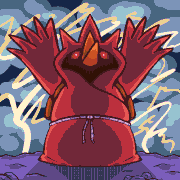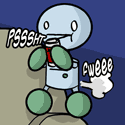|
Thermopyle posted:Install new LSI MegaRAID card with a couple of new drives. Grub menu appears on boot, but then nothing happens after selecting Ubuntu. Ok, maybe this isn't a grub problem. After I select Ubuntu on the grub menu, I just get a blank screen and nothing ever happens. Editing the menu entry and removing quiet nosplash doesn't change that. How do I figure out whats going on?
|
|
|
|

|
| # ? Jun 5, 2024 00:19 |
|
fletcher posted:Is there a command I can run in Linux Mint 16 MATE that can disable/enable a second monitor? xrandr --output <output> --off Where <output> is the output you want to disable. Run xrandr without arguments to see which ones you have and if they are connected or not.
|
|
|
|
fletcher posted:Is there a command I can run in Linux Mint 16 MATE that can disable/enable a second monitor? If you are looking for a way to do this from console, you will need xrandr. I'm not on Linux right now, but the syntax should be something like this: code:e;fb
|
|
|
|
Sweeeeet thanks guys, worked great. I wanna file a bug report but I'm not sure who the recipient should be...or what the right way to describe the issue is. When I boot up my multi-monitor VM with VirtualBox and try to drag a window over to the right it only lets me go this far:  If I maximize the window this is what I get:  And now thanks to you guys I can fix it by running (doing it through the UI was getting annoying): code:
|
|
|
|
|
Thermopyle posted:Ok, maybe this isn't a grub problem. After I select Ubuntu on the grub menu, I just get a blank screen and nothing ever happens. Editing the menu entry and removing quiet nosplash doesn't change that. What is the exact model of your LSI megaraid card? Probably the first thing I would do is boot from removable media, attempt to mount the raid, and see if everything looks alright with the file system.
|
|
|
|
fletcher posted:Sweeeeet thanks guys, worked great. I wanna file a bug report but I'm not sure who the recipient should be...or what the right way to describe the issue is. Did you just blur out... Your music library? Is it nothing but Rebecca Black and The Wiggles?
|
|
|
|
keyvin posted:What is the exact model of your LSI megaraid card? Probably the first thing I would do is boot from removable media, attempt to mount the raid, and see if everything looks alright with the file system. It's a 9240-8i. It's being used a JBOD controller, so there's no raid. If I unplug all drives from it, the system boots fine. I'll boot from removable media in a little while.
|
|
|
|
Thermopyle posted:It's a 9240-8i. It's being used a JBOD controller, so there's no raid. If I unplug all drives from it, the system boots fine. I'll boot from removable media in a little while. That might not be necessary. I assumed your install was on a drive connected to the card. If that isn't the case does appending verbose or debug to the boot parameters in grub cause the kernel to spit anything helpful out?
|
|
|
scroogle nmaps posted:Did you just blur out... Your music library? Had to hide my Justin Bieber playlists man
|
|
|
|
|
Come on man, you don't have to be ashamed. Be a Belieber!
|
|
|
|
keyvin posted:That might not be necessary. I assumed your install was on a drive connected to the card. If that isn't the case does appending verbose or debug to the boot parameters in grub cause the kernel to spit anything helpful out? Nope, as soon as I get past the screen for editing the boot parameters (I tried both verbose and debug options) it's a blank screen and the system never boots. If I disconnect the two drives from the fanout cable and boot the system it boots fine and hwinfo --storage-ctrl gives me this about the card: pre:39: PCI 200.0: 0104 RAID bus controller
[Created at pci.318]
Unique ID: B35A.1+oh_z9uuqE
Parent ID: CvwD.rxZe+G5lxF1
SysFS ID: /devices/pci0000:00/0000:00:05.0/0000:02:00.0
SysFS BusID: 0000:02:00.0
Hardware Class: storage
Model: "LSI Logic / Symbios Logic RAID bus controller"
Vendor: pci 0x1000 "LSI Logic / Symbios Logic"
Device: pci 0x0073
SubVendor: pci 0x1000 "LSI Logic / Symbios Logic"
SubDevice: pci 0x9240
Revision: 0x03
Driver: "megaraid_sas"
Driver Modules: "megaraid_sas"
I/O Ports: 0x9e00-0x9eff (rw)
Memory Range: 0xfb9fc000-0xfb9fffff (rw,non-prefetchable)
Memory Range: 0xfb980000-0xfb9bffff (rw,non-prefetchable)
Memory Range: 0xe7a00000-0xe7a1ffff (ro,non-prefetchable,disabled)
IRQ: 16 (2897 events)
Module Alias: "pci:v00001000d00000073sv00001000sd00009240bc01sc04i00"
Driver Info #0:
Driver Status: megaraid_sas is active
Driver Activation Cmd: "modprobe megaraid_sas"
Config Status: cfg=new, avail=yes, need=no, active=unknown
Attached to: #11 (PCI bridge)
|
|
|
|
Well, I thought grub 2 had gotten smart and if the root parameter was wrong it would try to find the right drive or spit out an error. This is probably the most ghetto way to go about it, but if you edit the grub entry for your ubuntu install and note which hd (they start at 0) it is using for the root parameter, then start a grub shell by pressing ctrl-c. You can type 'root(hdX' where X is the number in the menu entry, followed by tab grub will spit out the list of partitions on the drive at position X. If this matches the drive that your boot partition is on, then the drive order hasn't changed because of the additional drives. If it doesn't match, try editing the root parameter to the right hard drive. That is my last (probably worthless) idea. Edit: not the root= option on the kernel line, but something like 'set root=' or 'root(hdx' SYSV Fanfic fucked around with this message at 23:00 on May 15, 2014 |
|
|
|
keyvin posted:Well, I thought grub 2 had gotten smart and if the root parameter was wrong it would try to find the right drive or spit out an error. This is probably the most ghetto way to go about it, but if you edit the grub entry for your ubuntu install and note which hd (they start at 0) it is using for the root parameter, then start a grub shell by pressing ctrl-c. You can type 'root(hdX' where X is the number in the menu entry, followed by tab grub will spit out the list of partitions on the drive at position X. If this matches the drive that your boot partition is on, then the drive order hasn't changed because of the additional drives. If it doesn't match, try editing the root parameter to the right hard drive. Hmm, as I boot from an mdadm device it has the UUID for root: code:If I go into the grub shell and type ls / it shows the contents of my boot mdadm array, and if I understand correctly ls / will show contents of the root device. I just can't figure out how to get any info about what is preventing boot!
|
|
|
|
Thermopyle posted:Hmm, as I boot from an mdadm device it has the UUID for root: No it shouldn't be a boot order problem then. I looked it up, and there is more you need to do to see the verbose messages. https://wiki.ubuntu.com/DebuggingKernelBoot quote:Starting with Natty (Ubuntu 11.04), also remove the parameter vt.handoff=7, and on the line that reads set gfxpayload=$linux_gfx_mode, replace with set gfxpayload=text Do that and add verbose to the commandline and see if you see anything different.
|
|
|
|
The drives I hooked up were just a couple of old drives I had lying around. Turns out that I picked up two drives that had had mdadm arrays on them in the past and for some reason they were preventing ~stuff~ from happening. I deleted the MBR and partitions on them and everything booted fine. I never got around to trying your last advice to get debugging information because for some reason this idea just popped into my head. Thanks for your help!
|
|
|
|
Thermopyle posted:The drives I hooked up were just a couple of old drives I had lying around. Turns out that I picked up two drives that had had mdadm arrays on them in the past and for some reason they were preventing ~stuff~ from happening. I have zero idea how that would have prevented booting unless they had been members of your root array. Anyone know?
|
|
|
|
keyvin posted:I have zero idea how that would have prevented booting unless they had been members of your root array. Anyone know? It doesn't really make any sense, but what made more more sure it was the problem was when I went into the grub menu for "advanced ubuntu boot options" or whatever, and selected the most recent recovery kernel. That shows all the boot messages, and halfway through the boot, it errors out assembling my boot array and drops me into a busybox initramfs prompt. Wipe the two drives, and it boots fine regularly and into the recovery kernel.
|
|
|
|
Some RAID cards will not touch the data unless you do some kind of initialization and depending on which one you use it can be lazy about that too even. Plus device orders can go crazy. I have seen machines that the devices change randomly if you reboot it a few times.
|
|
|
|
Is anyone else running apt-cacher-ng? Debian apt had a bug a version or so back that prevented it updating from mirrors properly which is now fixed, but its only working with apt directly. When I use apt-cacher-ng to update my local network box, it displays the same errors apt had. I've tried cleaning the cache and a few other things but I'm wondering what it depends on that is replaying these errors?
|
|
|
|
How can I set up a bash alias that lets me use flags? I thought if I did this in .bashrc: code:
|
|
|
|
fuf posted:How can I set up a bash alias that lets me use flags? That is how it works. Did you open a new shell or source the .bashrc after you modified it? (source the file by doing '. ~/.bashrc')
|
|
|
|
uh yeah it works now. I'm pretty sure I did reload .bashrc so I'm not sure what was going on.
|
|
|
|
I finally sat down and upgraded my file server to x64, was a very straightforward process and everything booted just fine. Unfortunately my munin graphs are now broken as rrd files are architecture specific. I've been doing some reading on how to fix it and it appears the only solution is to dump the rrd files with the 32-bit rrdtool then import them with the 64-bit tool. The lovely thing is that I'm all 64-bit here, anyone have an idea on how I can dump the files on a 64-bit system? I'm probably going to have to setup a 32-bit vm on my laptop to do this.
|
|
|
|
Why can't you just install the 32bit version of Munin?
|
|
|
|
Ashex posted:I finally sat down and upgraded my file server to x64, was a very straightforward process and everything booted just fine. Unfortunately my munin graphs are now broken as rrd files are architecture specific. I've been doing some reading on how to fix it and it appears the only solution is to dump the rrd files with the 32-bit rrdtool then import them with the 64-bit tool. You only need the rrdtool binary to do the conversion, have you tried downloading the 32bit rpm /deb / whatever and extracting the binary and seeing if it will run? Otherwise yeah, you'll you need to use a live cd / vm to convert them.
|
|
|
|
Yeah, I tried it but it simply wouldn't execute due to library dependencies. I ended up setting up a VM and doing a dump through it.
|
|
|
|
I'm trying to mount 4 encrypted LUKS devices on boot using Ubuntu Server 14.04. Using /etc/crypttab and referencing the appropriate keyfiles, I can successfully mount all of the partitions with no issues. However, rather than mounting the drives at the stage of "mounting early crypto disks", they are mounted right at the tail end of the boot process ("mounting remaining crypto disks" or somesuch). This is too late in the boot process for my needs as I'm trying to assemble a ZFS array using these disks. The instructions in the FAQ here state that the solution is to quote:Add encrypted LUKS devices to the /etc/initramfs-tools/conf.d/cryptroot configuration such that all pool members are unlocked and ready before the regular system starts. I don't have this file automatically generated but creating it with the content below and running update-initramfs correctly prompts for the passphrase very early on in the boot process and the ZFS array assembles correctly. However, when I add ",key=/path/to/key" to the end of each line, I'm still prompted for a password for each volume. The keyfile is contained on the root partition. code:Does anyone have an example /etc/initramfs-tools/conf.d/cryptroot file they could post, specifically one referencing a keyfile please? How do /etc/crypttab and /etc/initramfs-tools/conf.d/cryptroot interact? I seem to be able to comment out /etc/crypttab entirely and still decrypt the disks on boot (with a passphrase) which was surprising. On Debian 7, all that seems to be necessary is just completing /etc/crypttab and restarting which seems much simpler. There is no cryptroot file created for Debian 7, but the disks are nevertheless decrypted at the beginning of the boot process. Edit: Just to be clear, my root filesystem is an unencrypted Ext4 USB stick - these ZFS volumes are used for data storage rather than for the OS. Prince John fucked around with this message at 13:37 on May 18, 2014 |
|
|
|
Prince John posted:I'm trying to mount 4 encrypted LUKS devices on boot using Ubuntu Server 14.04. Using /etc/crypttab and referencing the appropriate keyfiles, I can successfully mount all of the partitions with no issues. However, rather than mounting the drives at the stage of "mounting early crypto disks", they are mounted right at the tail end of the boot process ("mounting remaining crypto disks" or somesuch). Instead of adding just the "key" option, try adding it like this: ",keyscript='cat',key=/path/to/key". At least on Debian 7, the "key=" option is used just as an argument to the keyscript. If keyscript is not specified, then the key= option ends up being completely ignored. Prince John posted:How do /etc/crypttab and /etc/initramfs-tools/conf.d/cryptroot interact? I seem to be able to comment out /etc/crypttab entirely and still decrypt the disks on boot (with a passphrase) which was surprising. On Debian 7, all that seems to be necessary is just completing /etc/crypttab and restarting which seems much simpler. There is no cryptroot file created for Debian 7, but the disks are nevertheless decrypted at the beginning of the boot process. On Debian 7, /usr/share/initramfs-tools/hooks/cryptroot script will auto-generate a cryptroot file for initramfs. It will contain the crypt targets required to activate the root filesystem and perhaps the swap area. This file is stored inside the initramfs, so you won't normally see it anywhere unless you extract an initramfs and view its contents. But you can override this auto-generated file by supplying your own in /etc/initramfs-tools/conf.d/cryptroot. The cryptroot file is used in the initramfs phase of the boot process, when even the root filesystem is not mounted yet. There is no /etc/crypttab in initramfs, so all the information to activate the encrypted root filesystem (and/or other filesystems, if you so choose) must come from the user or be included in the cryptroot file. On Debian 7, "man 5 crypttab" tells me that there is a "noearly" option for /etc/crypttab. Perhaps this is flipped around in Ubuntu, and you'll need to specify something like "early" or "nolate" to activate a particular encrypted disk at "mounting early crypto disks".
|
|
|
|
I used Mint version 4 (Daryna) many moons ago, and then Mint version 5 (Elyssa). Never been great with Linux but always clicked with Mint. Recently acquired a netbook which came with Ubuntu, but I've since removed that and installed Mint 16 (Petra) cinnamon. Everything is great, love it. Except one thing... Why does the menu take so darn long to load after clicking it? After reading about it, it appears to be a problem with cinnamon of which I can find no solution to. Any ideas? And also, what's with all this cinnamon and mate stuff? What was wrong with simple Gnome? Or have i missed something?
|
|
|
|
Angelwolf posted:what's with all this cinnamon and mate stuff? What was wrong with simple Gnome? Or have i missed something? Gnome 3 made some pretty big changes to how the desktop worked.
|
|
|
|
keyvin posted:Gnome 3 made some pretty big changes to how the desktop worked. So gnome 3 came along, annoyed people, and cinnamon and mate came as a result of it? Gnome 2 is unsupported now then, I'm guessing?
|
|
|
|
I like Xubuntu because I get the old gnome2 feel and it's pretty snappy. 
|
|
|
|
Angelwolf posted:So gnome 3 came along, annoyed people, and cinnamon and mate came as a result of it? IIRC mate is a fork of gnome 2 they are working on porting to GTK3.
|
|
|
|
Yeah, I'm using a Gnome 2 theme right now on Mate, and the Gnome Color Chooser works fine too.
|
|
|
|
Right, got it. Thanks for the info about gnome and mate. So what's the deal with cinnamon, and does anyone know how to fix the slow loading menu problem? Mate environment shows no slowdown at all, but cinnamon likes to just chill before reacting.
|
|
|
|
Angelwolf posted:Right, got it. Thanks for the info about gnome and mate. What version are you running? I installed the Mint 17 RC with Cinnamon 2.2 on an older computer with painfully slow disks and the menu is quick and responsive in the new version.
|
|
|
|
When Gnome 2 came out everyone freaked and whined and complained and then got used to it. Its the circle of life.
|
|
|
|
JHVH-1 posted:When Gnome 2 came out everyone freaked and whined and complained and then got used to it. Its the circle of life. Gnome 3 was enough to make me abandon Gnome, and I haven't looked back since. I understand that having a UI geared to fingerpainting is a thing now (see Windows 8), but I personally neither want nor need it.
|
|
|
|
Everything Gnome is working on at the moment is getting irritating to use. Their loving UI choices are annoying as poo poo. I dont know why you would ditch the near universal File Edit View Help standards. Their current look for Gedit infuriates me It has 4 options and they're not intuitive on what the gently caress they do. I shouldn't have to hover over an icon to wait for the popup saying "Create new Document" or "Save" If you're going to do this Programs 2.0 Interface atleast use the standard icon schemes that have been around since the 90s. Save uses the Floppy Disk icon. New is a piece of paper with the right side folded. gently caress! I feel like some doddering old man now.
|
|
|
|

|
| # ? Jun 5, 2024 00:19 |
|
YouTuber posted:Everything Gnome is working on at the moment is getting irritating to use. Their loving UI choices are annoying as poo poo. I dont know why you would ditch the near universal File Edit View Help standards. Their current look for Gedit infuriates me It has 4 options and they're not intuitive on what the gently caress they do. I shouldn't have to hover over an icon to wait for the popup saying "Create new Document" or "Save" If you're going to do this Programs 2.0 Interface atleast use the standard icon schemes that have been around since the 90s. Save uses the Floppy Disk icon. New is a piece of paper with the right side folded. Those are our default icons. I don't know what icon theme you're using.
|
|
|





























